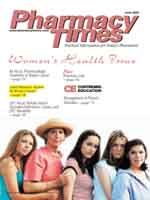Publication
Article
Pharmacy Times
Is an Antithyroid or an Antimetabolite Needed?
Problem
A community pharmacist accidentally dispensed the antithyroid medication propylthiouracil 50 mg instead of Purinethol (mercaptopurine) 50 mg, an antimetabolite, for a child with acute lymphoblastic leukemia. His parents noticed that the tablets looked different, but the pharmacist mistakenly believed that a generic product existed and reassured the parents that it was the correct drug. The child received the wrong drug for 6 months. No harm occurred, but he missed 6 months of chemotherapy. Modifications in the therapy and numerous thyroid blood level tests were needed.
This is one of several reports in which propylthiouracil was dispensed instead of Purinethol. Conversely, Purinethol has been dispensed and administered when propylthiouracil was prescribed. Because propylthiouracil doses often are several hundred milligrams a day, mistakes that result in giving Purinethol at these high doses could lead to significant harm, including bone marrow suppression, hepatotoxicity, immunosuppression, and teratogenicity. In 1 case reported to ISMP, the patient developed pancytopenia and hepatotoxicity.
The 2 products often are located next to each other, contributing to the risk of an error. Name similarity also is a problem. Although the drug names appear to be quite distinct, there are several common characters that may lead to confusion: both names start with "P" and end with "L"; 50 mg tablet strengths are common to both; and phonetically, the "your" sounds in "purine" and in "uracil" increase the risk of an error. Also, propylthiouracil is often abbreviated "PTU," which can be confused with "Purinethol" or even "6MP," a 3-digit abbreviation used for mercaptopurine.
Safe Practice Recommendations
On several occasions, GlaxoSmith-Kline, the manufacturer of Purinethol, has sent alerts to pharmacists about the potential for this type of error. Along with the most recent alert in June 2003, the company distributed "shelf shouters" that pharmacists can place wherever Purinethol is stored, to remind staff members about confusion with propylthiouracil and to have them confirm the indication with the patient. Pharmacists also might consider affixing auxiliary labels to the drug containers or adding alerts to their computers, especially if these drugs are not used frequently.
These 2 drugs never should be stored in close proximity. Even if prescriptions have been properly entered into the computer, the incorrect product could be selected if the 2 medications are near each other on pharmacy shelves. Pharmacies that use bar coding or match the drug container's national drug code number against the one listed in the computer database (and printed along with the label) are less likely to have the wrong container selected. Pharmacists should fully investigate patient-reported differences in tablet appearance. Some pharmacy computer systems can provide a picture of each tablet on the screen to help ensure accurate dispensing.
Of course, patients should be counseled before either of these medications is dispensed; the counseling session could quickly alert a pharmacist to a potential mix-up. Prescribers can help avoid errors, too, by listing brand and generic names as well the medication's purpose on prescriptions. Drug names should not be abbreviated; in particular, PTU and 6MP never should be used. If abbreviations are used, a pharmacist always should verify the order with the prescriber before dispensing the product.
Drs. Kelly and Vaida are both with the Institute for Safe Medication Practices (ISMP). Dr. Kelly is the editor of ISMP Medication Safety Alert! Community/ Ambulatory Care Edition, and Dr. Vaida is the executive director of ISMP.
Report Medication Errors
The reports described here were received through the USP Medication Errors Reporting Program, which is presented in cooperation with the Institute for Safe Medication Practices (ISMP). ISMP is a nonprofit organization whose mission is to understand the causes of medication errors and to provide time-critical error-reduction strategies to the health care community, policy makers, and the public. Throughout this series, the underlying system causes of medication errors will be presented to help readers identify system changes that can strengthen the safety of their operation. If you have encountered medication errors and would like to report them, you may call ISMP at 800-324-5723 (800-FAILSAFE) or USP at 800-233-7767 (800-23-ERROR). ISMP's Web address is www.ismp.org.
Subscribe to Newsletter Pharmacy Times and the Institute for Safe Medication Practices (ISMP) would like to make community pharmacy practitioners aware of a publication that is available.
The ISMP Medication Safety Alert! Community/Ambulatory Care Edition is a monthly compilation of medicationrelated incidents, error-prevention recommendations, news, and editorial content designed to inform and alert community pharmacy practitioners to potentially hazardous situations that may affect patient safety. Individual subscription prices are $45 per year for 12 monthly issues. Discounts are available for organizations with multiple pharmacy sites. This newsletter is delivered electronically. For more information, contact ISMP at 215-947- 7797, or send an e-mail message to community@ismp.org.







